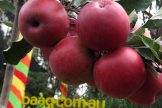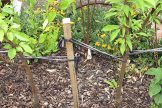
Queensland fruit fly is a significant pest that has been found in areas of Victoria for a few years now. Recently there is evidence the fly is establishing itself in Melbourne and surrounds. It feeds on a wide range of fruits and vegetables, and is understandably causing a great deal of anxiety for both home gardeners and commercial growers. Queensland fruit fly from the start of spring and through summer and autumn. They are able to survive mild winters as well.
Hosts
For a comprehensive list of fruit that can host Queensland Fruit Fly, please click this link.
Life cycle

Eggs
The female lays white eggs inside fruits and vegetables. The eggs are only about 1mm long and can be very difficult to see. One female QFF can lay up to 100 eggs per day.

Maggot (larva)
A small creamy coloured maggot hatches from each egg. The maggots eat the fruit and grow up to 9 mm long. Once fully grown they chew their way out of the fruit and burrow into the soil.
Pupa
Once in the soil, the maggot changes into an oval, brown, hard pupa. Inside the pupal case, the adult fly develops.
Adult fly
Adult flies emerge from the ground. They are about 7 mm long and reddish-brown in colour, with distinct yellow markings.
Control Options
If you grow any of the host fruit or vegetables you will need to start controlling for Fruit Fly at least 6 weeks before the fruit is ripe. Fruit Fly can lay eggs inside unripe fruit as well.

Traps
Fruit Fly traps use pheremones to lure the flies inside where they are either killed by an insecticide or trapped by a liquid or sticky surface. Traps are hung inside the foliage of the tree in a warm, shady spot out of the direct sunlight.
Baiting
Bait is applied onto the trunk and foliage of plants, not the fruit. The Fruit Flies are attracted to the bait and are killed by eating the insecticide.
It is important to know that these traps and baits can also attract and kill other beneficial insects.
Exclusion
Exclusion is done by creating a barrier made of insect netting. This can either be a net over the whole tree or small net bags that are placed over the fruit themselves. We sell both the netting (by the metre) and the bags. The nets and bags can be re-used each year. Exclusion allows you to protect fruit and vegetables, even if your neighbours are not actively controlling for Fruit Fly.
Insect netting – drape fine, UV stable mesh over your trees or a frame to protect fruit after pollination has occurred. You will need to secure the net around the base of the trunk or the ground to prevent the Fruit Flies from getting inside. Any fruit touching the netting may be infected through the net, so it’s important to avoid direct contact with fruit.
Bags and sleeves – when the fruit have set, place bags or sleeves over the fruit you want to keep. Secure them to the plant, ensuring there are no gaps where insects can enter. Remove and destroy any unwanted fruit.
Inspect ripening fruit
Check your ripening fruit and vegetables for Fruit Fly by looking for sting marks on skins or cutting them open to check inside for maggots.
Practice good garden hygiene
Keep your garden free from unwanted, fallen and rotten fruit to stop fruit fly from breeding in your garden. Remove any flowers or developing fruit that you are not protecting using a control method. Prune fruit trees to a height that allows you to easily pick fruit, apply an insect net or spray. Pick and use fruit as it ripens. Don’t leave infested fruit on trees or let it drop to the ground where the maggots can enter the soil and pupate.
Before disposing of fruit, destroy any maggots that may be inside by freezing, microwaving, boiling, or solarising (sealing fruit inside a plastic bag and leaving it in the sun for at least 14 days). The bagged fruit can then double bagged and discarded in your rubbish bin. DO NOT PUT IT IN YOUR GREEN BIN OR COMPOST.
Most of the information on this page has been sourced from Agriculture Victoria.
Pic 1 – Ag WA
Pic 2 – Ag Victoria





